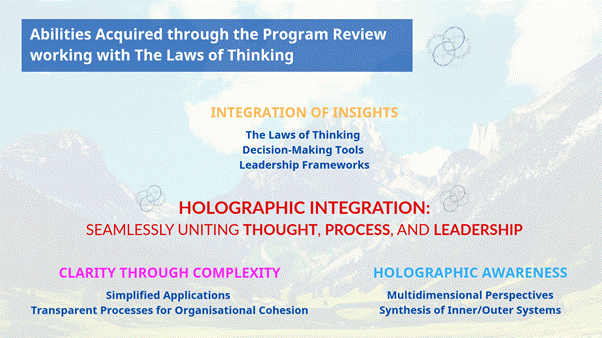Holographic Leadership
Insert (CLP) Photograph on Web Page (Align Right)
The Appleton Greene Corporate Training Program (CTP) for Holographic Leadership is provided by Dr. Mosimann-Kogan Certified Learning Provider (CLP). Program Specifications: Monthly cost USD$2,500.00; Monthly Workshops 6 hours; Monthly Support 4 hours; Program Duration 48 months; Program orders subject to ongoing availability.
Personal Profile
Dr. Mosimann-Kogan is a neuroscientist, shamanic practitioner, leadership consultant, and author with over 30 years of transformative experience across various disciplines and industries. She is dedicated to helping individuals and organisations understand how their consciousness shapes their reality and why success and fulfilment can be achieved through an inside-out approach.
Growing up alongside her father’s development of an acting technique based on Konstantin Stanislavski’s System, Dr. Mosimann-Kogan observed how the backstage and frontstage of theatre reflect our internal and external realities. Her quest to understand the mechanisms of consciousness has driven her ever since!
Earning her doctorate in behavioural neuropharmacology from the University of Nottingham, Dr. Mosimann-Kogan began her career in pharmaceutical R&D, progressing through various sales, marketing, and advertising roles before transitioning into strategic leadership positions.
As principal of her father’s academy for dramatic arts, she guided the school through organisational restructuring and later served as its board chair for a decade. Her leadership continues to shape numerous forward-thinking strategies and transformational programs, including her current role as the founder of a personal development consultancy, which she established in 2017.
Dr. Mosimann-Kogan’s unique approach integrates updated insights from acting and directing methodology, with quantum science, ancient wisdom traditions, soul psychology, and systems thinking, leading to profound personal and professional transformations.
Her methodology enables clients to cultivate holographic self-awareness and connect with their higher minds. It provides them with comprehensive tools that strike a balance between broad vision and attention to detail, equipping them to tackle modern leadership challenges and prepare them for future advancements.
Dr. Mosimann-Kogan’s decade-long global travels provided her with the opportunity for extensive research into spiritual and philosophical traditions and their views on consciousness. This included the study of plant medicine facilitation in India and Peru. Since settling in Zurich, Switzerland, she has incorporated all these insights into structured programs designed to deepen self-awareness, transform thought patterns, and inspire authentic leadership.
Dr. Mosimann-Kogan empowers leaders by enhancing clarity of thought, refining decision-making, and strengthening communication while driving improved teamwork and organisational performance. Her distinctive approach blends neuroscience, quantum science, creative methodologies, and ancient wisdom to effectively tackle modern business challenges.
By cultivating self-awareness and authentic leadership, her work helps leaders align personal growth with professional success. Using her innovative inside-out framework, Dr. Mosimann-Kogan transforms challenges into sustainable achievements, fostering transformational leadership and long-term success.
To request further information about Dr. Mosimann-Kogan through Appleton Greene, please Click Here.
(CLP) Programs
Appleton Greene corporate training programs are all process-driven. They are used as vehicles to implement tangible business processes within clients’ organizations, together with training, support and facilitation during the use of these processes. Corporate training programs are therefore implemented over a sustainable period of time, that is to say, between 1 year (incorporating 12 monthly workshops), and 4 years (incorporating 48 monthly workshops). Your program information guide will specify how long each program takes to complete. Each monthly workshop takes 6 hours to implement and can be undertaken either on the client’s premises, an Appleton Greene serviced office, or online via the internet. This enables clients to implement each part of their business process, before moving onto the next stage of the program and enables employees to plan their study time around their current work commitments. The result is far greater program benefit, over a more sustainable period of time and a significantly improved return on investment.
Appleton Greene uses standard and bespoke corporate training programs as vessels to transfer business process improvement knowledge into the heart of our clients’ organizations. Each individual program focuses upon the implementation of a specific business process, which enables clients to easily quantify their return on investment. There are hundreds of established Appleton Greene corporate training products now available to clients within customer services, e-business, finance, globalization, human resources, information technology, legal, management, marketing and production. It does not matter whether a client’s employees are located within one office, or an unlimited number of international offices, we can still bring them together to learn and implement specific business processes collectively. Our approach to global localization enables us to provide clients with a truly international service with that all important personal touch. Appleton Greene corporate training programs can be provided virtually or locally and they are all unique in that they individually focus upon a specific business function. All (CLP) programs are implemented over a sustainable period of time, usually between 1-4 years, incorporating 12-48 monthly workshops and professional support is consistently provided during this time by qualified learning providers and where appropriate, by Accredited Consultants.
Executive summary
Holographic Leadership
Given the current organisational climate, leadership development needs to be completely rethought. The demands on modern leaders are relentless, with growing complexity, constant change, and increasing pressure to balance innovation with sustainability. Traditional leadership approaches often focus on external behaviours or business strategies but fail to address the fundamental factor that shapes a leader’s ability to thrive—their consciousness.
At the heart of this program lies the understanding that beliefs shape reality. A leader’s consciousness operates as their reality-creating machine, influencing how they perceive challenges, decisions, and opportunities. The observer effect, a principle rooted in quantum mechanics, reminds us that where we direct our attention profoundly influences our outcomes. When leaders become aware of their internal thought patterns, biases, and beliefs, they gain the ability to intentionally redefine their focus, catalysing meaningful change from within.
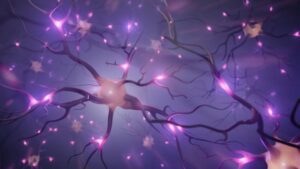 Modern leadership challenges stem from limitations in perception and awareness. Organisational silos, a lack of meaningful collaboration, and relentless performance demands create an environment where even the most capable leaders feel constrained—leading to fatigue, burnout, and ultimately reduced effectiveness. Without addressing these internal limitations, efforts to drive innovation, alignment, and resilience are often short-lived and unsustainable.
Modern leadership challenges stem from limitations in perception and awareness. Organisational silos, a lack of meaningful collaboration, and relentless performance demands create an environment where even the most capable leaders feel constrained—leading to fatigue, burnout, and ultimately reduced effectiveness. Without addressing these internal limitations, efforts to drive innovation, alignment, and resilience are often short-lived and unsustainable.
 The success of Bridgewater Associates, one of the most consistently high-performing hedge funds, illustrates the transformational impact of focusing on leadership consciousness. Under Ray Dalio’s leadership, Bridgewater emphasised radical transparency, systems thinking, and self-mastery, enabling it to thrive in volatile markets. These principles illustrate how internal clarity and intentional alignment fuel organisational success.
The success of Bridgewater Associates, one of the most consistently high-performing hedge funds, illustrates the transformational impact of focusing on leadership consciousness. Under Ray Dalio’s leadership, Bridgewater emphasised radical transparency, systems thinking, and self-mastery, enabling it to thrive in volatile markets. These principles illustrate how internal clarity and intentional alignment fuel organisational success.
Holographic Leadership builds upon this foundation by expanding beyond self-mastery and systems thinking to incorporate multidimensional awareness and a profound understanding of the human experience. This approach integrates structured frameworks that explore the soul’s journey, its mission, purpose, themes, and fulfilment. Leaders are empowered not only to address challenges in the present but also to connect with their higher purpose and align their actions with a vision of long-term transformation and impact.
 Unlike traditional methods, which address surface-level symptoms, Holographic Leadership provides a transformative inside-out approach. By understanding how their consciousness shapes reality, leaders can unlock untapped potential for creative problem-solving, authentic connection, and intentional collaboration. The inclusion of multidimensional awareness enables leaders to transcend reactive patterns and engage with challenges from a more elevated perspective, fostering clarity, purpose, and resilience.
Unlike traditional methods, which address surface-level symptoms, Holographic Leadership provides a transformative inside-out approach. By understanding how their consciousness shapes reality, leaders can unlock untapped potential for creative problem-solving, authentic connection, and intentional collaboration. The inclusion of multidimensional awareness enables leaders to transcend reactive patterns and engage with challenges from a more elevated perspective, fostering clarity, purpose, and resilience.
 By blending analytical methods with the principles of consciousness, emotional intelligence, and soul psychology, the Holographic Leadership program offers a framework for long-term self-alignment and professional growth. Sharper decision-making, improved teamwork, and resilient organisational cultures deeply connected to their missions and purposes become the norm for leaders. These outcomes shift leadership from reactive to intentional, ensuring clarity and alignment even in the face of complexity.
By blending analytical methods with the principles of consciousness, emotional intelligence, and soul psychology, the Holographic Leadership program offers a framework for long-term self-alignment and professional growth. Sharper decision-making, improved teamwork, and resilient organisational cultures deeply connected to their missions and purposes become the norm for leaders. These outcomes shift leadership from reactive to intentional, ensuring clarity and alignment even in the face of complexity.
 This innovative mindset inspires leaders to elevate their approach, resolve complexity with grace, and channel their full potential into creating sustainable success. Backed by an understanding of how beliefs shape outward realities and the unique insights of the soul’s journey, Holographic Leadership represents a paradigm shift for those ready to lead with authenticity, multidimensional awareness, and purpose in an increasingly interconnected world.
This innovative mindset inspires leaders to elevate their approach, resolve complexity with grace, and channel their full potential into creating sustainable success. Backed by an understanding of how beliefs shape outward realities and the unique insights of the soul’s journey, Holographic Leadership represents a paradigm shift for those ready to lead with authenticity, multidimensional awareness, and purpose in an increasingly interconnected world.
Curriculum
Holographic Leadership – Part 1- Year 1
- Part 1 Month 1 Awakening Awareness
- Part 1 Month 2 Formative Events
- Part 1 Month 3 Mindprint Actions
- Part 1 Month 4 Finishing Thinking
- Part 1 Month 5 Implementation Planning
- Part 1 Month 6 Grounded Leadership
- Part 1 Month 7 Creative Flow
- Part 1 Month 8 Confident Decision-Making
- Part 1 Month 9 Compassionate Connection
- Part 1 Month 10 Authentic Expression
- Part 1 Month 11 Catalysing Visions
- Part 1 Month 12 Cohesive Purpose
Holographic Leadership – Part 2- Year 2
- Part 2 Month 1 Prosperity Awareness
- Part 2 Month 2 Knowledge Pathways
- Part 2 Month 3 Momentum Dynamics
- Part 2 Month 4 Opening Gateways
- Part 2 Month 5 Navigating Challenges
- Part 2 Month 6 Honouring Stillness
- Part 2 Month 7 Partnership Evolution
- Part 2 Month 8 Protection Systems
- Part 2 Month 9 Justice Implementation
- Part 2 Month 10 Motion Intelligence
- Part 2 Month 11 Mastering Flow
- Part 2 Month 12 Completing Transformation
Holographic Leadership – Part 3- Year 3
- Part 3 Month 1 Creative Foundations
- Part 3 Month 2 Collective organisation
- Part 3 Month 3 Humble Advancement
- Part 3 Month 4 Viewpoint Perspective
- Part 3 Month 5 Nourishing Innocence
- Part 3 Month 6 Influence Management
- Part 3 Month 7 Family Systems
- Part 3 Month 8 Visionary Transition
- Part 3 Month 9 Revolutionary Change
- Part 3 Month 10 Developmental Maturitys
- Part 3 Month 11 Inner Truth
- Part 3 Month 12 Cohesive Embodiment
Holographic Leadership – Part 4- Year 4
- Part 4 Month 1 Origin Research
- Part 4 Month 2 Perceptual Evaluation
- Part 4 Month 3 Deliberate Evaluation
- Part 4 Month 4 Energy Analysis
- Part 4 Month 5 Emotional Assessment
- Part 4 Month 6 Environmental Congruence
- Part 4 Month 7 Relational Analysis
- Part 4 Month 8 Present Awareness
- Part 4 Month 9 Value Alignment
- Part 4 Month 10 Evolutionary Examination
- Part 4 Month 11 Group Evaluation
- Part 4 Month 12 Holographic Integration
Program Objectives
The following list represents the Key Program Objectives (KPO) for the Appleton Greene Holographic Leadership corporate training program.
Holographic Leadership – Part 1- Year 1
- Part 1 Month 1 Awakening Awareness – Introducing participants to the fundamental concept of awareness, we emphasise understanding the interplay between the Lower and Higher Mind. Cultivating awareness is essential for dismantling limiting beliefs and enhancing leadership potential. This module examines Mind Erosions — habits and subconscious conditioning that hinder growth and adaptability. By exploring how thoughts and beliefs shape perceptions and behaviours, participants investigate Soul Cycles. Each incarnation allows the soul to learn specific lessons, explore diverse experiences, and integrate new understandings. Recognising these cycles helps leaders understand both past and present influences, enabling profound personal and professional transformation. By integrating these insights, they create an environment where growth is continuous and aligned with a multidimensional perspective.
- Part 1 Month 2 Formative Events – Participants enhance their authenticity as leaders by exploring the connection between personal experiences and leadership dynamics, providing valuable insights into the nature and influence of Complexes. Analysing significant past events shapes their thinking, beliefs, and behaviours. Reflective practices help identify recurring themes, preparing for future challenges with intentionality and clarity. The module introduces the concept of Purposes, emphasising how conscious and unconscious driving factors align with personal fulfilment and leadership intentions. Leaders cultivate a deeper connection between their personal and professional aspirations by recognising unacknowledged values that disrupt leadership harmony.
- Part 1 Month 3 Mindprint Actionss – This module enhances self-understanding to boost leadership effectiveness. Participants explore the relationship between intention and purpose, guiding them to articulate their key intentions clearly. This clarity promotes proactive leadership, shifting from reactive responses to influenced dynamics. The introduction of the Mindprint framework illustrates subconscious belief systems, serving as a foundational tool for ongoing transformation. Leaders identify and shift outdated beliefs into empowering frameworks that align with their evolving vision, fostering a dynamic and purposeful leadership approach.
- Part 1 Month 4 Finishing Thinking – Developing integrity in Actions — authentic mindfulness — is vital for effective leadership. This module explores the connection between intention and behaviour, illustrating how authentic action enhances leadership effectiveness. Participants learn that aligning intention with action fosters transparency, trust, and accountability within teams. Techniques for identifying and resolving unresolved thought patterns, known as Finishing-Off Thinking, are introduced. Embracing the practice of Foffting enhances clarity and nurtures dynamic thought processes, ultimately strengthening decision-making and promoting a mindful leadership presence.
- Part 1 Month 5 Implementation Planning – Transitioning to the planning phase, this module focuses on implementing the Holographic Transformation Framework (HTF). Participants reevaluate the planning process, identifying challenges and goals and clarifying purposes. They learn to design a strategic implementation plan, aligning the framework with organisational objectives. This preparation phase is crucial for establishing a solid foundation for the subsequent modules, ensuring cohesive integration of the framework into daily leadership practices and addressing potential obstacles proactively.
- Part 1 Month 6 Grounded Leadership – Starting with the Root Chakra, we highlight security and stability as essential foundations of effective leadership. Participants explore how their sense of security impacts innovation and risk tolerance. Through embodied techniques, leaders uncover where they operate out of fear or are firmly rooted in their truth. The program investigates how early experiences with safety and belonging shape modern team stability and organisational structure. Participants acquire techniques for maintaining composure amid volatility, fostering a creative and supportive environment grounded in personal stability.
- Part 1 Month 7 Creative Flow – This module explores the emotions that drive creativity and problem-solving. Participants tap into their creativity, emotional fluidity, and skills in finding solutions. By examining how creativity impacts their teams and organisations, leaders become more comfortable embracing emotional awareness as a key leadership skill. Through experiential exercises, they identify obstacles to creative flow, such as demands for control or fear of judgment. The module fosters psychological safety and trust within teams, promoting collaborative strategies and creative engagement.
- Part 1 Month 8 Confident Decision-Making – Confidence in leadership inspires action. This module explores the connection between the Solar Plexus, decisive action, confidence, and personal authority. Participants assess their relationship with authority and how power dynamics influence their leadership style. By recognising when they operate from submission or domination, they develop the ability to embody centered authority. The module examines how fluctuations in confidence affect team performance and organisational culture while promoting strategies to maintain a balanced and authentic presence.
- Part 1 Month 9 Compassionate Connection – The Heart Chakra module explores empathy, relationships, and organisational harmony. Participants investigate how both self-directed and outward compassion influence team cohesion and culture. The curriculum addresses vulnerability as an asset, assisting leaders in balancing transparency with professional boundaries. By fostering trust through heart-centred leadership, participants enhance psychological safety, performance, and innovation within their organisations.
- Part 1 Month 10 Authentic Expression – This module explores the role of the Throat Chakra in facilitating clear communication and authentic expression. Participants investigate verbal and nonverbal strategies that enhance their leadership impact and the transmission of vision. They tackle common communication challenges and identify unconscious behaviours that may cause misunderstandings. By cultivating clear internal thoughts, participants improve their external articulation, promoting authentic and effective communication.
- Part 1 Month 11 Catalysing Vision – The Third Eye Chakra module explores leadership vision, intuition, and foresight. Participants learn to balance analytical thinking with perceptual insight, enhancing their strategic decision-making and innovation. By differentiating between intuition and fear or wishful thinking, leaders build confidence in their intuitive abilities, fostering creative solutions to complex challenges.
- Part 1 Month 12 Cohesive Purpose – The final module connects the Crown Chakra to knowledge integration, greater purpose, and holistic leadership. Participants explore how their leadership aligns with a purpose transcending individual success, promoting organisational well-being. By synthesising insights from previous modules, they develop a personalised leadership philosophy. This module emphasises leadership that aligns with purpose, fostering resilience and clarity in challenging situations while laying the groundwork for meaningful, lasting leadership..
Holographic Leadership – Part 2- Year 2
- Part 2 Month 1 Prosperity Awareness – Abundance consciousness and primal strength form the foundations of effective leadership. Through Fehu, participants explore how their beliefs about resources influence their capacity for sustainable prosperity. Leaders identify and transform unconscious scarcity patterns, recognising opportunity in all circumstances. Uruz introduces enduring strength and momentum, helping participants distinguish between forceful control and resilient persistence. Prosperity begins with internal resourcefulness rather than external circumstances. Leaders examine how physical vitality and nervous system regulation affect decision-making and team energy. Through embodied practices, participants develop awareness of how they access and distribute life force, identifying patterns of unnecessary energy expenditure versus strategic strength application. Integrating an abundance mindset with sustainable energy management, leaders establish capacities for transformational journeys. Prosperity creates value across stakeholder relationships, aligning leadership with principles of regenerative growth.
- Part 2 Month 2 Knowledge Pathways – Constructive disruption and inspired communication are essential for transforming leadership. Through Thurisaz, participants explore resistance and challenge as catalysts for growth, reframing obstacles as opportunities for evolution. Leaders distinguish between destructive conflict and the necessary tension that drives innovation. Ansuz introduces higher inspiration and message clarity, helping participants access wisdom beyond analytical thinking while communicating their vision effectively. Leaders examine inherited communication patterns, transforming limiting habits. Receptivity is emphasized as a prerequisite for genuine authority, with practices for stillness enabling inspired insight. By integrating strategic disruption with clear communication, leaders initiate necessary change while maintaining stakeholder trust. Transformational leadership requires challenging the status quo and articulating compelling alternatives that inspire collective action towards shared visions.
- Part 2 Month 3 Momentum Dynamics – Purposeful movement and illuminating insight enhance leadership capabilities. Through Raidho, participants examine their personal and organisational journeys, identifying patterns of resistance, acceleration, or misalignment that impact progress. Rhythmic timing represents a form of leadership intelligence, acknowledging cycles of action and consolidation instead of forcing continuous motion. Leaders reflect on their relationships with authority and control, steering teams with the appropriate pace and direction. Kenaz introduces knowledge and creative revelation, clarifying the difference between information accumulation and transformative insight. Effective leadership necessitates methodical processes alongside breakthrough thinking. Leaders explore their learning edges and knowledge gaps, offering innovative perspectives. By integrating directional clarity with revelatory insight, participants devise comprehensive strategies to address challenges. Masterful leadership involves guiding teams through change, illuminating the path with purpose and vision.
- Part 2 Month 4 Opening Gateways – Exchange and fulfilment dynamics are explored in leadership contexts. Through Gebo, participants explore giving and receiving, identifying imbalanced patterns in relationships or cultures. Generosity and receptivity are complementary leadership strengths that recognise how imbalanced giving and receiving undermine connection and impact. Leaders examine partnership agreements, raising awareness of expectations and contributions. Wunjo introduces authentic joy and harmonious alignment, enhancing performance and well-being. Participants explore how fulfilment influences culture, recognising that joyless achievement is unsustainable while purposeful satisfaction generates renewable energy. Meaningful leadership creates conditions for mutual benefit and fulfilment. By integrating balanced exchange and joy, leaders develop sustainable approaches that honour interconnected ecosystems. Opening to reciprocity and fulfilment transforms transactional management into lasting relational leadership.
- Part 2 Month 5 Navigating Challenges – This module addresses leadership during disruption and constraint, exploring limitations and chaos as catalysts for innovation. Through Hagalaz, participants examine their relationship with change and disruption, identifying reactive patterns. Disruptive events serve as evolutionary accelerators, distinguishing between destructive chaos and transformative upheaval. Nauthiz introduces creative constraint, recognising limitations as sources of unprecedented solutions. Leaders respond to resource constraints and obstacles, transforming frustration into determination. Masterful leadership involves riding the storms of change and harnessing creative potential within limitations. Participants develop resilience and adaptability by integrating responses to disruption and innovative approaches to constraints. Navigating challenges with wisdom transforms crises into opportunities, guiding organisations through uncertainty with both stability and creativity.
- Part 2 Month 6 Honouring Stillness – Strategic stillness and cyclical timing enhance leadership effectiveness. With Isa, participants examine their relationship with pause and consolidation, identifying where excessive action undermines progress. Intentional stillness is a leadership strength, recognising how contraction supports expansion. Leaders explore their comfort with uncertainty, remaining present during inaction. Jera introduces natural cycles and timing, aligning leadership with organic growth processes. Patience and timing are emphasised as key leadership competencies. Integrating stillness with cyclical awareness, participants develop sustainable approaches to challenges, honouring growth phases. Mastery in leadership involves decisive action and attentive waiting, creating space for natural developments.
- Part 2 Month 7 Partnership Evolution – Polarity integration and emergent possibility are key in evolutionary leadership. Through Eihwaz, participants explore how opposites function as complementary forces, transcending binary thinking in complex situations. Contradictions — stability/change and structure/flexibility — generate solutions when held together. Leaders examine polarised perceptions and their limits. Perthro introduces emergent potential, developing comfort with ambiguity as a fertile space for possibilities. Integrated thinking honours complexity and openness to emergence. Navigating paradoxes while remaining receptive enhances adaptive responsiveness. The partnership between structured understanding and open receptivity creates leadership capable of generating sustainable solutions to unprecedented challenges..
- Part 2 Month 8 Protection Systems – Boundary intelligence and success thinking are crucial for leadership. Through Algiz, participants examine their relationship with protection and vulnerability, identifying boundary issues. Appropriate boundaries support authentic connections, distinguishing defensive reactivity from discerning protection. Leaders explore boundary patterns that influence team safety and culture. Sowilo introduces success consciousness, challenging limiting beliefs about achievement. Sustainable success requires protective discernment and an expansive vision. Integrating boundary wisdom with a success orientation balances safeguarding resources while remaining open to possibilities. Masterful leadership protects valuable assets and illuminates pathways to achievement, creating systems that provide security and inspire excellence.
- Part 2 Month 9 Justice Implementation – Principled discernment and nurturing growth balance leadership contexts. Through Tiwaz, participants examine justice and fairness, identifying rigidity or conflict avoidance. Principled leadership upholds standards with compassion, navigating ethical complexity. Leaders explore how justice orientation impacts team dynamics and culture, recognising that perceptions of fairness influence engagement. Berkano introduces nurturing development, striking a balance between accountability and support. Transformational leadership requires boundaries and nurturing, fostering environments for growth. By integrating judgment with support, participants develop performance management approaches. Justice promotes growth, aligning leadership with integrity and compassionate development.
- Part 2 Month 10 Motion Intelligence – Synchronised movement and collective intelligence enhance leadership. Through Ehwaz, participants explore leadership via the horse-and-rider metaphor, identifying imbalances in partnership. True partnership respects varied capacities working toward objectives. Leaders reflect on the dynamics of authority and autonomy. Mannaz introduces collective wisdom, honouring diverse perspectives as valuable resources. Complex challenges require coordinated movement and multiple viewpoints, integrating action with intelligence. Awareness of partnership dynamics and community wisdom enhances collaboration. Motion intelligence involves acknowledging synchronised harmony and interconnectedness.
- Part 2 Month 11 Mastering Flow – Emotional intelligence and seed potential are explored in leadership. Through Laguz, participants examine flow states and emotional currents, identifying resistance or reactivity. Emotional fluency is a leadership strength that navigates unseen organisational dimensions. Leaders explore uncertainty comfort, trusting emergent processes. Ingwaz introduces potential and gestation, recognising that transformation requires protected incubation. Masterful leadership navigates emotional reality and protects potential during development. Integrating responsiveness with patient cultivation, participants approach innovation and change. Flow mastery allows momentum while protecting core potential for sustainable manifestation.
- Part 2 Month 12 Completing Transformation – Breakthrough awareness, heritage wisdom, and surrender to mystery are explored in leadership. Through Dagaz, participants examine paradigm shifts and insights, recognising that breakthrough awareness transforms leadership. Illumination results from preparatory work, creating quantum awareness shifts. Othala introduces inherited wisdom, preserving valuable traditions while transforming limiting patterns. Evolutionary leadership honours heritage while transcending past limitations. The Blank Rune (Wyrd) represents surrender to greater wisdom, fostering comfort with uncertainty. By integrating consciousness, heritage wisdom, and unknowing, leaders navigate complexity with innovative and grounded approaches. Completion signifies an ending and a beginning — a threshold between integrated understanding and ongoing discovery in leadership and organisational transformation.
Holographic Leadership – Part 3- Year 3
- Part 3 Month 1 Creative Foundations – This core topic examines the complementary ideas of creative initiation and receptive reaction in leadership execution. Participants study how pure creative force manifests in their leadership through Hexagram 1 (Creative Heaven), recognising that visionary direction generates momentum and may overwhelm systems unprepared for swift transformation. By introducing collaboration between initiative and accommodation, Hexagram 2 (Receptive Earth) helps leaders realise that clear directives and responsive adaptations are necessary for successful implementation. Early growth challenges, youthful excitement, and strategic waiting, as illustrated in Hexagrams 3-6, assist participants in executing new projects with an understanding of developmental stages and timing. Grasping the relationship between assertive action and patient nurturing, as well as between creative vision and practical reality, is foundational for implementing a strategic plan. Leaders examine their implementation patterns to identify mismatches between force and receptivity, which can create resistance or a lack of momentum. Participants develop more efficient methods for transforming vision into a sustainable reality by integrating contextual awareness and directed purpose. This module establishes the foundation for the application of implementation intelligence throughout the program.
- Part 3 Month 2 Collective Organisation – This module explores harmonious leadership and disciplined teamwork in complex systems. Participants examine how organised cooperation and a distinct hierarchy facilitate coordinated activity towards shared goals through Hexagram 7 (Army), highlighting instances where a lack of structure impairs implementation efficacy. Hexagram 8 (Holding Together) introduces the idea that formal organisation must be tempered with sincere relationships and cohesion to sustain participation. Hexagrams 9-12 expand on these concepts, helping leaders apply strategies that balance structure and flexibility, detail and big picture, and advancement and consolidation. Successful implementation requires disciplined coordination and genuine connection — systems that facilitate coordinated action while fostering belonging and commitment. Leaders analyse their organisational strategies to identify where overbearing control or a lack of structure impedes implementation. By combining relationship-centred leadership with methodical organising, participants create balanced methods for implementing complex initiatives. Collective organisation works best when human relationships and formal structures support rather than undermine one another, resulting in systems that exploit both natural involvement and order.
- Part 3 Month 3 Humble Advancement – This topic examines strategies for progress and successful implementation. Participants explore how community cooperation promotes sustainable advancements through Hexagram 13 (fellowship), recognising that competitive individualism may compromise the efficacy of group implementation. Hexagram 14 (Great Possession) suggests that abundance arises from the community, directing leaders to implement policies that foster shared ownership and benefits. Hexagrams 15-18 elaborate on these themes, assisting leaders in methods that balance leadership and followership, confidence and humility, enthusiasm and cautious analysis. Successful implementation requires forward momentum and honest evaluation of areas needing improvement. Leaders assess progression trends to identify where overambition or insufficient correction leads to imbalances. By combining modest progress with appropriate intervention, participants cultivate sustainable implementation strategies. Progress occurs naturally when leaders are self-aware, engage others in a common goal, develop procedures, and value achievement and continuous development.
- Part 3 Month 4 Viewpoint Perspective – This lesson explores the significance of perspective in implementation efficacy. Using Hexagram 19 (Approach), participants assess how opportunity perception influences engagement and momentum, identifying narrow perspectives that limit possibilities. Hexagram 20 (Contemplation) pairs this idea with reflective observation, emphasising action-informed context and dynamics. Hexagrams 21-24 assist leaders in understanding how different viewpoints illuminate opportunities and intervention areas, highlighting the importance of shifting perspectives. Leaders evaluate their perceptual tendencies to identify blind spots from fixed perspectives. Participants develop comprehensive implementation plans by leveraging diverse perspectives, combining contemplative observation with active engagement. This flexibility in perspective enables leaders to address complex situations with decisive actions and nuanced understanding, creating an implementation advantage by revealing opportunities that are invisible from singular viewpoints.
- Part 3 Month 5 Nourishing Innocence – This module explores how proper maintenance and nourishment ensure sustainability in implementation. Using Hexagram 25 (Innocence), participants investigate how simple authenticity builds confidence during change processes, highlighting where political scheming or overly complex implementation undermines credibility. Hexagram 26 (Great Accumulation) introduces the idea that genuine simplicity allows for significant resource gathering, trust and transparency, attracting necessary support. Hexagrams 27–30 emphasise proper nourishment, systemic renovation, recurring challenges, and enlightened clarity, guiding leaders to execute projects with long-term viability in mind. Innocent directness and effective resource management are essential for successful implementation. Leaders assess maintenance strategies to identify areas where neglecting basic needs creates implementation vulnerability. Participants develop sustainable techniques that endure in complex and high-pressure environments by combining clear aims with extensive support systems.
- Part 3 Month 6 Influence Management – Hexagram 31 (Influence) explores the dynamics of impact and persistence in strategic implementation. Participants investigate how subtle persuasion and magnetic attraction accelerate implementation, recognising that excessive force or a lack of participation creates resistance. Hexagram 32 (Duration) complements this approach by emphasising consistent presence over intermittent action, which is essential for sustainable change. Hexagrams 33-36 explain the importance of stepping back, being strong, making steady progress, and bouncing back from difficulties, helping leaders manage projects while being aware of recurring patterns. Effective implementation requires knowing when to exert influence, conserve energy, demonstrate progress, and tactically retreat. Leaders assess influence patterns to identify where power imbalances create inefficiencies. Blending sustainable persistence with magnetic influence, participants develop change management strategies, maintaining momentum without burnout. Influence management equips leaders to make a significant impact with minimal opposition by modulating energy effectively.
- Part 3 Month 7 Family Systems – Through Hexagrams 39-42, participants explore how the dynamics of relationships impact the execution, navigating obstacles, reducing burdens, and increasing supportive assistance. The lesson focuses on understanding the “family system” within organisational structures — how hierarchies, alliances, and unwritten rules affect adopted changes. Leaders assess their organisation’s families to identify relationship patterns that present obstacles or opportunities for execution. By combining clear role definitions with an appreciation for constructive differences, participants create strategies that capitalise on their interpersonal strengths to resolve systemic dysfunction. Enhanced relational intelligence gives leaders an edge in implementation, empowering them to handle delicate interpersonal situations with greater tact and understanding.
- Part 3 Month 8 Visionary Transition – Hexagram 43 (Breakthrough) explores breakthrough moments and consolidation processes essential for revolutionary execution. Participants analyse instances when established patterns disintegrate, and new opportunities emerge, identifying where delays or haste hinder timing. Hexagram 44 (Coming to Meet) introduces the idea that breakthroughs require receptive interaction with emerging forces — active preparation aligning with opportune moments. Hexagrams 45–48 expand on accumulated abundance, upward mobility, exhaustion management, and resource deepening, helping leaders execute projects while recognising that transformative moments require provocation and consolidation. Effective implementation requires knowing when to push forward and when to integrate. Leaders review their transition strategies to identify volatility from lack of courage or insufficient consolidation. By merging breakthrough courage with effective stabilisation, participants develop methods fostering lasting transformation instead of short-term disruption.
- Part 3 Month 9 Revolutionary Change – Hexagram 49 (Revolution) explores fundamental change and its impact on implementation, highlighting instances where cautious or careless disruptions lead to dysfunction. Hexagram 50 (The Cauldron) introduces the need for structural supports to channel transformative energy during a revolution constructively. Hexagrams 51–54 elaborate on arousing shocks, quiet cultivation, progressive development, and appropriate posture while guiding leaders to execute revolutionary efforts, understanding that disruptive change requires stabilising structures and catalytic actions. We emphasise the importance of timing during revolutionary periods — determining when systems are prepared for change and strategising disruptions to minimise disruption. Leaders analyse innovative strategies to identify poor timing choices that cause destabilisation or resistance. Participants foster transformative change that honours disruption by fusing revolutionary vision with realistic staging while ensuring a stable transition.
- Part 3 Month 10 Developmental Maturity – We examine how to manage peak abundance and transitions during implementation cycles using Hexagram 55 (Abundance), learning to leverage essential situations without excess. Hexagram 56 (The Wanderer) suggests that abundance can lead to change, emphasising the need to be prepared for it even when circumstances are favourable. Hexagram 56 (The Wanderer) conveys the idea that abundance fosters transition, highlighting the importance of being ready for change even during success. Hexagrams 57–60 address gentle engagement, joyful communication, dispersal dynamics, and embracing limitations. They assist leaders in executing projects while acknowledging that maximum effectiveness requires celebration and preparation for inevitable change. Implementation maturity is shaped by one’s attitude toward success, maintaining humility and flexibility amid high achievement. Leaders evaluate their relationships with abundance, identifying complacency or resistance as sources of vulnerability. By merging an appreciation for peak conditions with readiness for change, participants develop strategies that are effective in growth and contraction cycles.
- Part 3 Month 11 Inner Truth – Hexagram 61 (Inner Truth) examines inner alignment and transitional completeness in implementation, highlighting instances where straying from core values jeopardises effectiveness. Inner truth manifests through right action, where small, consistent alignments create a significant impact, paired with Hexagram 62 (Small Exceeding). Hexagrams 63-64 address completion dynamics and unfinished transitions, aiding leaders in executing projects while keeping accomplishment milestones and ongoing development in mind. The program challenges linear development views by emphasising the importance of celebrating achievements and recognising new starting points. Leaders assess their attachment to final outcomes, which can impede implementation due to resistance to renewal. By merging milestone acknowledgement with openness to new possibilities, participants gain perspectives that celebrate success while embracing change. Inner truth provides a competitive edge, enabling leaders to adapt while maintaining integrity.
- Part 3 Month 12 Cohesive Embodiment – This final module synthesises the knowledge acquired throughout the year through comprehensive integration and preparation for real-world application. Participants reflect on their developmental journeys to uncover critical insights, turning points, and continuous growth opportunities. Through structured reflection sessions, leaders create tailored implementation frameworks that integrate I Ching’s wisdom with their leadership contexts and challenges. By emphasising practical embodiment, the module translates conceptual understanding into consistent behavioural change. Participants develop detailed integration plans outlining short-term applications and long-term growth. Peer consultation processes provide feedback that enhances implementation strategies and accountability. Participants define specific behavioural changes and measurable outcomes by establishing concrete pathways from discovery to application. The year concludes with a ceremonial recognition of the transformation journey and a commitment to ongoing practice, encouraging sustained development beyond the program..
Holographic Leadership – Part 4- Year 4
- Part 4 Month 1 Origin Research – Leaders apply the first four laws to trace visible process results to the underlying ideas that produced them. They examine early mental models that shaped process design and question whether foundational assumptions remain true while analysing current procedures. This thorough study highlights discrepancies between process intentions and actual outcomes, offering insights for improvement. For instance, when evaluating a customer onboarding process, leaders review the stages and measures and the underlying beliefs about customers that shaped its design, questioning, “What assumptions about our customers are embedded in this process?”
- Part 4 Month 2 Perceptual Evaluation – Laws 5-8 help leaders understand how various stakeholders perceive the same process from different angles. This perceptual analysis uncovers deeper systemic issues and highlights blind spots in assessment methods by demonstrating how divergent opinions signal underlying problems. Grasping these viewpoints enables leaders to reframe limiting perspectives that obstruct process improvement. By gathering input from stakeholders — customers, frontline staff, and management — leaders pinpoint perceptual discrepancies between the intended process and the actual experience, striving to align these for improved outcomes.
- Part 4 Month 3 Deliberate Evaluation – Laws 9-12 guide leaders in assessing whether process results align with initial goals. This evaluation identifies if processes empower or unintentionally disempower individuals due to unforeseen effects. Leaders examine if the process purpose has evolved since implementation and strive to align procedures with current organisational objectives. For example, in evaluating a decision-making process, leaders assess whether the original goal of enhancing cooperation is met or if it has devolved into a bureaucratic exercise, merely checking boxes without fostering true collaboration.
- Part 4 Month 4 Energy Analysis – Laws 13-16 prompt leaders to identify where processes either generate or deplete organisational energy. This analysis uncovers mental patterns that obstruct improvement projects and maps energy flows across related activities. Understanding these energy dynamics helps leaders direct resources toward optimising processes that maximise vitality instead of draining it. Tracking team energy levels before, during, and after key processes reveals which activities energise members and which exhaust them, highlighting opportunities for energy-conscious process redesign.
- Part 4 Month 5 Emotional Assessment – Laws 17-20 enable leaders to evaluate how processes impact stakeholders emotionally. This assessment integrates emotional intelligence with process optimisation techniques, identifying areas of emotional resistance within workflows. Leaders gain a comprehensive understanding of process effectiveness by combining logical measures with indicators of emotional well-being. For instance, when assessing performance evaluation processes, leaders consider not only completion rates but also their impact on employee emotional states, determining whether they foster growth mindsets or provoke defensive reactions that hinder development and engagement.
- Part 4 Month 6 Environmental Congruence – Laws 21-24 allow leaders to determine whether processes provide an enabling or limiting environment for those interacting with them. This assessment evaluates if physical and cultural settings support process objectives and identifies unseen environmental factors affecting performance. Leaders learn to create environments that naturally support desired processes. For example, evaluating both physical and virtual workspace design can reveal how these environments either facilitate or hinder collaboration, suggesting changes that improve process efficiency without altering the process itself.
- Part 4 Month 7 Relational Analysis – Laws 25-28 direct leaders to assess how processes influence interdepartmental and interteam relationships. This study evaluates whether processes enhance or undermine organisational linkages, highlighting relational patterns that result from process interactions. These insights enable leaders to rework procedures to foster cooperative partnerships instead of reinforcing silos. For example, examining procurement procedures can reveal how they influence supplier relationships, identifying trends that suggest strengths or weaknesses and pointing to opportunities for transforming transactional processes into relationship-building tools that generate mutual value.
- Part 4 Month 8 Present Awareness – Laws 29-32 instruct leaders to observe processes with present-moment awareness instead of historical bias. This approach helps them see unintentional trends in process execution and recognise when procedures are followed mindlessly rather than deliberately. By incorporating awareness checks in process evaluations, leaders gain fresh perspectives on old tasks. One effective method is conducting “process gemba walks,” where leaders observe processes in action with full focus, spotting subtle details and dynamics missed in document reviews or retrospective analyses.
- Part 4 Month 9 Value Alignment – Laws 33-36 enable leaders to evaluate whether processes support declared organisational values or contradict them. This study identifies value conflicts embedded in procedures and assesses discrepancies between process intentions and actions. Leaders can then realign processes with core values, ensuring consistency between the organisation’s stated commitments and its practices. For example, reviewing hiring procedures against diversity and inclusion principles can uncover areas where actions diverge from commitments, leading to process redesigns that truly reflect the organisation’s values.
- Part 4 Month 10 Evolutionary Examination – Laws 37-40 allow leaders to determine whether processes stagnate or facilitate innovation and growth. This analysis reveals self-limiting aspects in process design and evaluates whether processes support continuous development. Leaders learn to incorporate self-correcting mechanisms into processes, ensuring they evolve with the organisation. For instance, assessing quality improvement initiatives can reveal whether these efforts foster genuine evolution or maintain the status quo, prompting changes that shift quality management from preservation to innovation.
- Part 4 Month 11 Group Evaluation – Laws 41-42 guide leaders to assess how processes influence group consciousness and organisational culture. This evaluation identifies opportunities to create processes that elevate organisational awareness and highlights unintentional group agreements sustaining ineffective processes. Leaders examine whether processes enhance or diminish group intelligence and unity. For example, studying decision-making procedures reveals how they impact the organisation’s ability to respond to challenges cohesively. Leaders then redesign these processes to promote group intelligence and unified action.
- Part 4 Month 12 Holographic Integration – In the final module, leaders integrate knowledge from all 42 Laws into a comprehensive evaluation approach. This synthesis enables the creation of action plans that address processes holographically, viewing both detailed mechanics and systemic patterns simultaneously. Leaders design next-generation processes that reflect elevated consciousness and develop measurement tools that capture multidimensional process effects. The goal is to view parts and the whole simultaneously, executing changes that positively influence the entire system by synthesising results from applying all 42 Laws to create an integrated organisational operations vision.
Methodology
Holographic Leadership
Program Planning
Year 1 utilises the Holographic Transformation Framework (HTF), which has been developed over forty years, to establish the foundation for lasting change.
The “Foundations of Transformational Leadership and Self-Mastery,” modules 1–4 explain why we think the way we do and provide vocabulary, tools, and structured guidance for transforming restrictive mental processes.
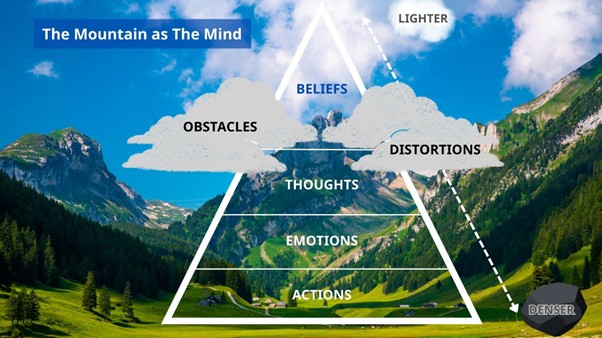
During this preplanning phase, we explore the mechanisms of both the aware and unaware minds, particularly how they interact with each other and how these interactions influence strategic decisions and behaviours.
With a comprehensive overview of the framework before planning how to adapt it, clients can observe how invisible thinking (thinking we don’t know we have) originates, what keeps it in place, and how to transform it.
We are now beginning to develop an agile mind and a good understanding of any resistance to change.
Leaders who commit to self-awareness and self-reflection, with a clear vision, purpose, and dedication to their fulfilment, will be keen to understand their automatic reactions that create problems and undermine team harmony, morale, and output.
Key subjects include Awareness — the ability to see one’s thinking — Complexes, Events, Purposes, Actions, and the Mindprint (our mental blueprint). We also discuss the Soul’s Cycles, Contracts, and Missions.
Module 5 represents a significant milestone as we draft and evaluate a plan of implementation that will be tested further based on the insights gained from Phase 2 of this year.
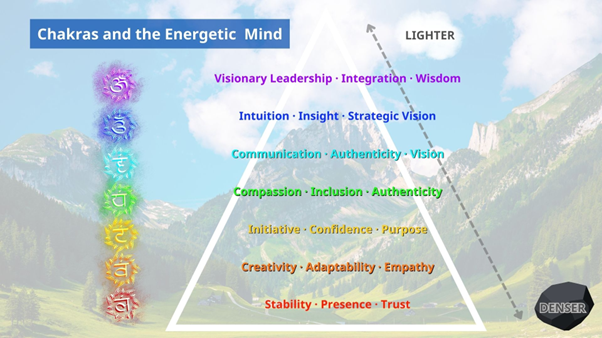
Modules 6-12 delve into the chakra system — the Energetic Mind an essential framework for developing one’s connection to one’s body and benefitting from its constant ego-less communication. In this phase, we incorporate regular, prompted journaling and meditative attunement sessions into the process to facilitate the slowing down of thoughts, energetic transformation, and connection to the higher mind. These features of the HTF methodology continue and evolve in the years to come.
We will cover the central themes of human experiences: everything from personal safety, security, and abundance to a sense of tribe, relationship dynamics, conscience, and open and effective communication through creative expression, visionary development, and connection to the higher mind. Working successively through these topics, participants explore deeper into self-enquiry, transformation, and release from outmoded beliefs, thoughts and behaviours.
This phase sharpens our self-awareness while refining our strategy for the upcoming year’s growth.
Program Development
Year 2 focuses on developing the Holographic Transformation Framework (HTF) implementation techniques as we evolve our multidimensional awareness.
This year, we are integrating ancient Norse runes with the continued self-enquiry with the chakra — Energetic Mind — system.
The recent allure of all things “Viking” pulls us into the many worlds of the Norse pantheon of pagan deities. The Norse provide a significantly different picture of gender than we see today, when bridging the gap between the feminine victim and the masculine perpetrator is vital. They push us to question prejudices that have constrained us.
As archetypal emblems of old knowledge, the runes emphasise the “warrior spirit” and “search for truth,” which are vital for any leader. Participants will simultaneously work with one chakra and two consecutive runes, adding a new dimension to their mental multitasking.
Recognising patterns is crucial and represents an important skill for developing consciousness. Clients will continue to explore the fascinating interrelationship of all fractals and their effect on the whole, and vice versa, while applying this awareness to their strategies and teams for greater cohesion.
Participants are invited to draw on Odin’s sacrifice at the Tree of Life, which represents the courage to let go of the negative ego, and ask, “What am I ready to let go of to lead authentically and effectively?” This ongoing process redefines power, flexibility, and balance, producing clarity, empathy, and breadth of vision.
Leaders continue to align their leadership approaches with the newly emerging values, ideals, and goals. This new awareness shapes innovative approaches to conflict management, decision-making, communication, and relationship dynamics, enabling people to prepare for the HTF implementation.
Revisiting the chakra system from Year 1 in greater depth alongside the runes enhances our understanding of the Energetic Mind and how the body and the sixth sense continually communicate with us. As old mind erosions are transformed, new mind prints are established, giving rise to new leaders.
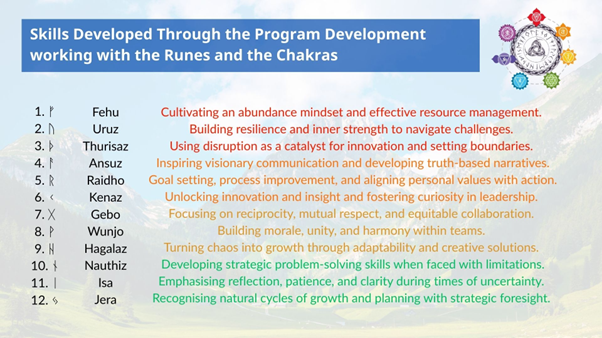
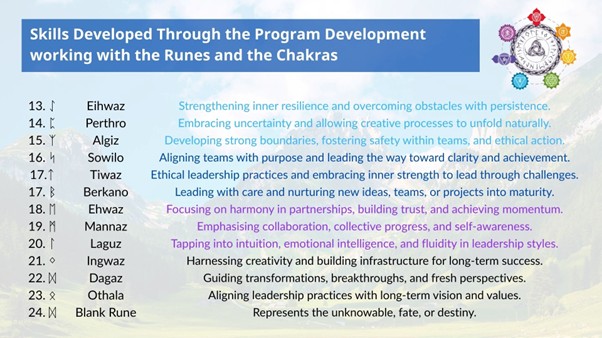
Holographic transformation converts conceptual ideas into embodied, warrior-like leadership qualities that are consistently integrated into practical environments. This process fosters a sincere, robust, and adaptable response to the changing demands of companies and teams.
With this, participants are now ready to level up to Year 3.
Program Implementation
Year 3 emphasises customising and implementing the Holographic Transformation Framework (HTF) and integrating the teachings of the I Ching.
Emerging in the Zhou Dynasty (1045-221 BCE), the I Ching combines Taoist philosophy, Confucianism, and ancient Chinese wisdom to assist leaders in achieving harmony with the rhythms of life and nature, promoting success.
Integrating the I Ching at this point offers a versatile and profoundly impactful structure perfectly designed to elevate expansive awareness and foster transformational leadership abilities.
The initial hexagrams provide valuable insights into initiative, creativity, and receptivity, encouraging leaders to understand the significance of strategic patience and the pacing of processes. Participants engage with these teachings to navigate initial challenges, gaining insight into the complexities of new projects while addressing entrenched biases and conflicts stemming from familial, cultural, social, and political backgrounds. This transformation significantly alters their viewpoints, fostering a more efficient approach to leadership.
In conjunction with the HTF, recognising that the success of each fractal is intertwined with overall success allows leaders to enhance their ability to manage team projects with sensitivity and strength, react promptly to changes, and uphold a flexible and harmonious leadership approach.
Analysing hexagrams that highlight sensible actions and meticulous planning enhances leaders’ transformational abilities, enabling them to turn periods of stagnation into opportunities for constructive reinvention. This element of the I Ching supports the implementation of changes and formulating strategic plans in organisations.
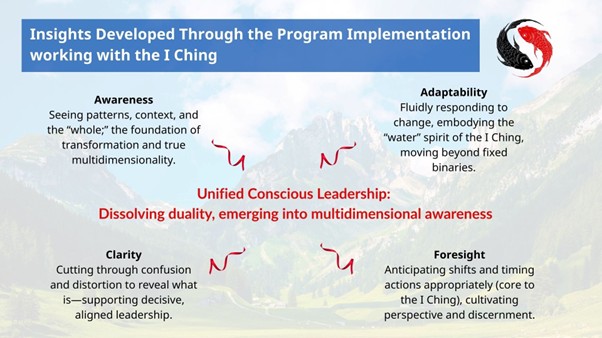
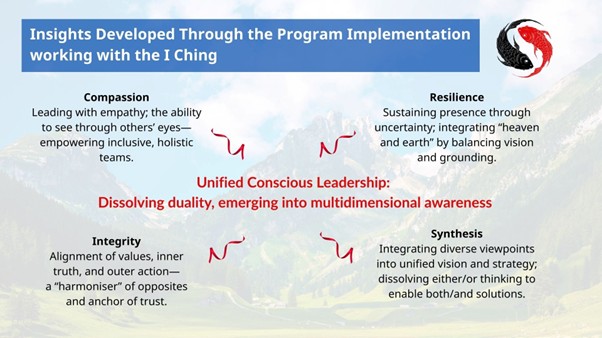
As participants advance, they interact with hexagrams that promote inclusive leadership and collaboration, uncovering the strength of humble and inspired action. They foster adaptability and transparency, upholding ethical standards in a constantly changing environment. The HTF fosters these qualities through a harmonious blend of modesty and assertiveness in its actions.
The year’s conclusion is marked by hexagrams that symbolise balance, clarity, connection, and rebirth. By incorporating these final lessons with HTF, leaders can effectively wrap up their transformational journey by addressing organisational challenges with a balanced perspective and a renewed sense of purpose. By embracing the wisdom of the I Ching, leaders cultivate a wide-ranging awareness and transformative abilities, ensuring their actions resonate with the natural rhythms of life and business, leading to a sustainable and ethically grounded leadership model.
Program Review
Year 4 emphasises evaluating and improving the implemented HTF using the (previously unpublished) 22 “Laws of Thinking”. This year, we focus on understanding the framework’s practical effects, fine-tuning its components, and ensuring it functions successfully while aligned with the company’s and its leaders’ needs.
The Laws of Thinking provide a solid theoretical foundation for this examination. These laws utilise dynamic cognitive and behavioural principles to analyse and advance participants’ experiential understanding of the holographic nature of consciousness.
Participants will apply these principles to evaluate their thinking processes, organisational methods, and leadership practices, ensuring the transformation framework is reliable while remaining adaptable to new opportunities and challenges.
The review process begins by reflecting on past experiences and results. We will examine the evolution of understanding from the foundational concepts of Year 1, the deeper insights from Year 2, and the hands-on applications from Year 3. This retrospective assessment reveals the multiple layers to one’s awareness, and the more that we see, the more that we see.
With this understanding, leaders better understand how to position and communicate new insights with those not sharing these same broad-vision perspectives.
All participants will contemplate and apply the Laws of Thinking to their personal, leadership, and organisational systems. The process involves thoroughly examining thinking habits, decision-making, and personal-professional alignment, closely reflecting on experiences in their reality. Participants will evaluate their current methods to uncover assumptions that require further analysis or thought processes that have led to suboptimal results. This comprehensive analysis helps them identify blind spots and refine their leadership goals.
Participants will share ideas and perspectives in transparent, respectful, and empathetic conversations and peer consultations throughout the year to promote collective learning and view these contributions as reflections of themselves. They will collaborate to develop enhanced leadership strategies, valuing their diverse experiences and viewpoints. The Laws of Thinking will guide reflective journaling, self-assessment, and meditative attunements during the review process.
This ongoing reflection enables individuals to monitor their progress and make timely adjustments based on cognitive and behavioural changes.
By evaluating and adjusting new methods, leaders will build a solid, adaptable HTF that can efficiently respond to changing organisational settings.
By the end of Year 4, participants will possess a well-researched and refined Holographic Transformation Framework alongside their advanced self-awareness skills.
This all-inclusive systems-thinking-based structure will be stronger and more adaptable to meet the complex needs of modern leadership.
Industries
This service is primarily available to the following industry sectors:
Healthcare
History
The healthcare sector has undergone significant transformation over the last decade, driven by societal demands and technological breakthroughs. The COVID-19 pandemic in 2020 accelerated the adoption of telemedicine by elevating virtual care and remote consultations. Concurrently, machine learning and artificial intelligence (AI) were integrated into operational management and diagnostics, enabling quicker and more accurate decision-making. Wearable technology has become an essential tool for monitoring patients in real-time, especially in managing chronic illnesses. Additionally, governments and private organisations have prioritised affordable care and improved access in underserved regions as part of a major expansion of efforts to make healthcare systems more equitable.
Current Position
To provide patient-centred, value-based care, healthcare today is an interconnected ecosystem of multidisciplinary services. Particularly in oncology and rare diseases, the emergence of precision medicine is resulting in individualised treatments catered to each patient’s needs. Traditional testing techniques have been revolutionised by AI-powered diagnostics, such as image recognition in radiology and pathology, which guarantee quicker and more accurate results. Big data and cloud storage platforms are now used by healthcare organisations to streamline operations and enable safe patient record management. The market for wearable health technology, which combines gadgets like smartwatches and fitness trackers with digital healthcare platforms, has grown steadily and is now providing regular consumers with lifestyle and health insights that were previously unattainable.
Healthcare leaders face several pressing challenges:
• Productivity: High patient-to-nurse ratios are a stark reality that negatively impacts both patient outcomes and staff morale.
• Employee Retention: Burnout is rampant. The National Academy of Medicine reports that 35-54% of U.S. nurses and physicians suffer significant burnout symptoms.
• Organisational Cohesion: Effective coordination across diverse departments is crucial yet challenging. Fragmented care can lead to medical errors and inefficiencies.
• Adapting to Technological Change: Although telehealth has experienced significant growth, establishing patient trust and protecting data remains a complex task.
• Regulatory Compliance: Navigating intricate regulations, especially with emerging tech like AI in healthcare, is challenging
Future Outlook
AI and machine learning are set to revolutionise diagnostics, treatment plans, and patient management. Personalised medicine, tailored to individual genetic profiles, will optimise treatment efficacy and minimise side effects.
Telehealth and remote monitoring will likely become ingrained in healthcare delivery, mainly benefiting rural and underserved regions by providing continuous data for proactive health management.
The exploration of how consciousness impacts health is gaining momentum, particularly through research into psychedelics as therapeutic tools. This could lead to groundbreaking treatments for mental health and end-of-life care.
Leaders will continue to face challenges such as:
• Retaining Talent: High turnover rates demand more sustainable work environments. The American Medical Association underscores the need for systemic changes to combat burnout.
• Technological Adaptation: Balancing innovation while ensuring patient data protection is key. Security breaches have reportedly increased with digital health records.
• Organisational Cohesion: Unity within increasingly complex healthcare organisations is crucial.
Biotechnology
History
With historic accomplishments such as the introduction of CRISPR-Cas9 gene-editing technology, which transformed genetic research and therapeutic advancements beginning in 2012, the past decade has been a golden age for biotechnology. During the COVID-19 pandemic, biotechnology’s influence increased significantly as mRNA vaccine technology, developed by firms like Pfizer and Moderna, proved essential in the fight against the virus. Innovation exploded in fields like cell and gene therapies, monoclonal antibodies, and regenerative medicine during this period, as venture capital funding for biotech startups reached all-time highs. Scientific advancements were further accelerated by the rising prevalence of collaborations between smaller biotech companies and larger pharmaceutical firms.
Current Position
Today, biotechnology is known for its innovative approaches to complex health issues. The industry focuses on areas like genetic engineering, bioinformatics, regenerative medicine, and biopharmaceuticals. Companies like Amgen, Genentech, and CRISPR Therapeutics lead the charge, continuously pushing scientific boundaries.
The “psychedelic renaissance” is particularly exciting, with biotech companies exploring psychedelics like psilocybin and LSD for their therapeutic potential. This research, aimed at treating mental health disorders and even providing palliative care for terminal illnesses, is transforming our understanding of the brain and consciousness.
Leadership faces several key challenges:
• Managing Innovation: Balancing groundbreaking research with regulatory compliance is tough. “Nature Biotechnology” highlights regulatory hurdles faced by innovative biotech firms.
• Talent Acquisition and Retention: Attracting top talent is competitive. The Biotechnology Innovation Organisation reports a talent shortage in areas like bioinformatics and genetic engineering.
• Funding and Resources: Securing funds for high-risk research is challenging. Venture capital is critical, but competition is fierce.
• Collaboration and Integration: Interdisciplinary collaboration is essential for innovation. The convergence of biotech and information technology underscores this need.
Future Outlook
The biotech sector’s future holds immense promise. Advances in gene-editing technologies, like CRISPR, could revolutionise medicine by enabling precise DNA modifications. This could lead to cures for genetic disorders and more effective, personalised treatments.
The study of consciousness, particularly through psychedelics, is expected to gain prominence. Understanding how these substances influence mental and subsequently physical health will demonstrate how understanding consciousness is key to developing new treatments.
Moreover, integrating bioinformatics and big data analytics will enhance our understanding of complex biological systems, leading to better healthcare predictions and solutions. The shift towards sustainability will drive bioengineering innovations, with agricultural biotech playing a crucial role in developing sustainable farming practices.
Leadership in biotech will need to tackle future challenges like:
• Regulatory and Ethical Frameworks: Keeping up with innovation while meeting stringent regulatory standards is vital.
• Interdisciplinary Collaboration: Promoting cross-field collaboration is crucial for progress.
• Sustainable Practices: Embracing eco-friendly bioprocesses is becoming increasingly important.
• Public Perception and Trust: Building trust through transparency and ethical conduct is crucial, particularly in the context of gene editing and synthetic biology.
Pharmaceuticals
History
Technological breakthroughs and shifting healthcare demands have led to significant changes in the pharmaceutical industry over the past decade. The COVID-19 pandemic highlighted the industry’s ability to innovate rapidly, as demonstrated by the 2020 development of mRNA-based vaccines and antiviral medications within a year. Nowadays, big data and artificial intelligence play a crucial role in pharmaceutical development by enabling in silico drug design, predicting compound success rates, and streamlining laborious clinical trials. While the development of biosimilars has democratised access to essential medications globally, increasing scrutiny of drug pricing has sparked efforts towards greater transparency and regulation.
Current Position
Fast-forward to today, and the pharmaceutical industry has grown into a global giant worth over $1.2 trillion. Big names like Pfizer, Johnson & Johnson, and AstraZeneca lead the field. The sector is constantly innovating, especially with cutting-edge developments in biotechnology and genomics.
But it’s not all smooth sailing. The industry faces several challenges:
• High R&D Costs: Developing a new drug is insanely expensive, often costing over $2.5 billion. With a high chance of failure in clinical trials, it’s a big gamble.
• Regulatory Compliance: Navigating the FDA’s intricate approval process is time-consuming and costly.
• Market Competition: The rise of generic drugs puts pressure on profit margins, especially when blockbuster drug patents expire.
• Global Health Issues: Tackling global health crises like antibiotic resistance and emerging infectious diseases requires massive investment and collaboration.
Future Outlook
The future looks bright for the pharmaceutical sector with plenty of novel avenues to explore:
• Personalised Medicine: Advances in genomics are paving the way for therapies tailored to our genetic profiles, promising better efficacy and fewer side effects.
• Regenerative Medicine: Think stem cell treatments that could potentially cure chronic conditions.
• Digital Health: Integrating AI-driven diagnostics and remote monitoring can revolutionise drug development and patient care.
• Sustainable Practices: There’s a growing emphasis on sustainability, driving innovations in eco-friendly manufacturing processes and biodegradable drugs.
Leaders in the pharmaceutical sector will need to tackle ongoing challenges, including:
• Balancing Innovation and Regulation: Keeping up with rapid scientific advancements while ensuring patient safety.
• Enhancing Collaboration: Fostering partnerships across sectors and disciplines to drive meaningful innovations.
• Building Public Trust: Ensuring transparent communication about the benefits and risks of new therapies.
• Managing Costs: Developing strategies to reduce drug development costs and improve accessibility.

Education
History
Over the past ten years, significant changes have occurred in the education sector, primarily due to the rapid development of technology. With colleges and school systems swiftly implementing digital classrooms and hybrid education models in 2020, the COVID-19 pandemic underscored the value of distance learning. AI applications in adaptive learning environments have facilitated the alignment of curriculum delivery with each student’s progress. Massive Open Online Courses (MOOCs), which provided previously exclusive groups worldwide with access to top-tier university resources, also experienced a considerable increase in adoption during this period. Meanwhile, STEM education is becoming increasingly vital in response to the needs of rapidly evolving tech-driven economies.
Current Position
Today, education is a dynamic mix of traditional classroom settings, online education, and hybrid models. Traditional powerhouses like Harvard and MIT are alongside innovative online platforms like Coursera and Khan Academy.
But there are challenges:
• Inequality in Access: Despite advancements, disparities in access to quality education remain. UNESCO reports that over 260 million children and youth are out of school globally.
• Adapting to Technology: Integrating technology into our education systems is challenging, with issues around infrastructure, teacher training, and digital literacy.
• Funding and Resources: Public education relies heavily on local funding, creating significant inequalities.
• Student Engagement: Keeping students engaged requires innovative and interactive approaches, especially in online or hybrid learning models.
Future Outlook
Looking ahead, the future of education is all about transformation:
• Personalised Learning: AI and machine learning will offer personalised learning experiences tailored to each student’s needs.
• Lifelong Learning: There’s a stronger focus on continuous professional development and lifelong learning to keep pace with the fast-changing job market.
• Global Collaboration: Expect more international exchange programs and collaborations, fostering a global perspective in education.
• Sustainable Education Practices: Sustainability is becoming a core part of curricula, preparing students to tackle global environmental issues.
Educational leaders face ongoing challenges:
• Equitable Access: Ensuring all students have equal access to quality education.
• Integrating Technology: Effectively incorporating technology while addressing issues of digital equity and literacy.
• Innovative Pedagogy: Developing teaching methods that engage students and enhance learning outcomes.
• Funding and Policy: Advocating for increased funding and supportive policies to address systemic disparities.

Technology
History
Technology has continuously transformed every facet of human existence over the last decade. As cloud computing proliferated, it enabled multinational corporations to operate at previously unprecedented levels. The improved connectivity of 5G networks began to revolutionise industries by facilitating real-time data sharing, particularly in applications related to the Internet of Things and healthcare. Blockchain technology evolved beyond its use in cryptocurrencies and entered sectors such as finance and supply chains. With machine learning algorithms trained to outperform humans in areas ranging from pharmaceutical research to language translation, artificial intelligence (AI) has made significant strides. Businesses have also responded to increasing demands for data storage and fibre optics, enhancing global digital accessibility.
Current Position
Today, the tech sector is all about innovation. Giants like Google, Amazon, and Tesla, along with countless startups, are pushing boundaries in AI, blockchain, and IoT (Internet of Things).
However, challenges abound:
• Rapid Pace of Innovation: Keeping up with the fast pace of change is tough for businesses. A McKinsey report highlights the need for continuous innovation and adaptability.
• Cybersecurity: The digital age has increased the risk of cyberattacks, affecting businesses and individuals alike.
• Privacy Concerns: Protecting data privacy in the age of big data and AI is a significant concern. The European GDPR is a testament to these challenges, enforcing stringent data protection measures.
• Ethical Implications: The ethical concerns tied to AI and autonomous systems are critical and need addressing. Studies from the AI Ethics Lab emphasise the need for ethical guidelines.
Future Outlook
The tech sector’s future is auspicious:
• AI and Machine Learning: These technologies will continue to revolutionise various industries, offering unprecedented insights and efficiencies.
• Quantum Computing: The development of quantum computers promises to solve complex problems beyond the reach of classical.
• Sustainability and Green Tech: There’s a growing focus on sustainable technologies, including renewable energy and eco-friendly manufacturing processes.
• Human-Technology Interaction: Enhancements in AR/VR, wearable tech, and brain-computer interfaces are set to improve our interaction with.
Tech leaders will need to navigate several key challenges:
• Ethical AI: Implementing guidelines to ensure that AI is used responsibly and without biases.
• Cybersecurity: Strengthening measures to protect against cyber threats and maintain trust.
• Privacy Management: Upholding robust data privacy practices to comply with regulations and protect user information.
• Sustainable Development: Integrating sustainable practices into tech development and operations to mitigate environmental impacts.
Locations
This service is primarily available within the following locations:
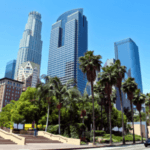
Los Angeles, LA
History
Los Angeles has evolved into a global hub for innovative ideas in entertainment, technology, healthcare, and sustainability over the past decade. Silicon Beach, home to more than 500 startups and the innovation divisions of tech giants such as Google, Snapchat, Hulu, and Disney, is at the forefront of this transformation. Two of the biggest names in entertainment, Netflix has invested billions of dollars annually in original programming since 2017. The city’s economic diversification is evident through its “smart city” initiatives and the accelerated development of eco-friendly infrastructure, including investments in clean energy and electric vehicle technologies. Although the COVID-19 pandemic posed significant challenges, it also spurred advancements in telemedicine and remote production technologies, further enhancing LA’s innovative landscape.
Current Position
Los Angeles is a hub of creativity and technology today. With a film, television, and music industry valued at $2.1 trillion, it remains the unequivocal entertainment capital of the world. Institutions such as UCLA Health and Cedars-Sinai have played significant roles in the growth of the healthcare and biotech sectors, leading advancements in genomic research and robotic surgery. Additionally, LA has established itself as a frontrunner in clean technology and environmentally friendly transportation. Its initiatives to electrify public transport and airport systems align well with the expansion of solar energy networks and substantial green infrastructure projects. The tourism sector also thrives, with visitors contributing over $44 billion annually, bolstering LA’s economic stability.
Future Outlook
Los Angeles is poised to lead in emerging fields such as virtual production, AI-driven content creation, telehealth, and advanced biomanufacturing. The city’s initiatives to combat climate change, including its ambitious goal of achieving carbon neutrality by 2045, align seamlessly with its technological aspirations. As a significant contributor to global industry trends, Los Angeles boasts a robust presence in clean energy technologies, medtech, and the creative economy. By fostering innovative ideas at the intersection of culture and business, LA is set to transform the way industries collaborate in the 21st century.

New York City, NY
History
In the past decade, New York City has established itself as a leading global centre for finance and innovation, seamlessly blending traditional and modern elements. The fintech sector has flourished, with emerging companies like Plaid and Stripe enabling faster and more accessible financial transactions. Initiatives such as the Cornell Tech campus on Roosevelt Island, which opened in 2017, have further solidified NYC’s status as a technology hub, attracting significant investment in areas like AI, cybersecurity, and quantum computing. In the wake of the pandemic, the city’s recovery strategies have included green infrastructure projects and programmes designed to revitalise the economy. These efforts have ensured that New York City remains at the forefront of sustainability and economic recovery.
Current Position:
New York City continues to excel in finance, technology, fashion, and real estate, with Wall Street exerting considerable influence over global markets. The city’s integration with fintech platforms streamlines cross-border transactions and enhances data analysis capabilities. Additionally, New York City is home to esteemed biomedical institutions such as the NY Genome Centre and Memorial Sloan Kettering, which are making significant advancements in cancer research and personalised medicine. Tourism, a crucial component of the city’s economy, has experienced a robust recovery, with annual visitor numbers nearly reaching pre-pandemic levels. Furthermore, New York City retains its status as a cultural and fashion capital, largely due to high-profile events such as New York Fashion Week and the dynamic art scenes in Chelsea and SoHo.
Future Outlook:
New York is well-positioned to set a benchmark for sustainable urban design, as the city makes substantial investments in green technologies and urban digitisation, including smart grids and autonomous vehicles. Key areas of growth include medtech innovation, AI-driven urban planning, and advanced financial modelling that utilises AI and blockchain. New York City remains a pivotal presence on the world stage, seamlessly blending culture and business. Its goal of achieving carbon neutrality by 2050, coupled with enhancements to its infrastructure, renders it increasingly attractive to ambitious enterprises and skilled individuals from around the globe.

Boston, MA
History
Boston has increasingly established itself as a leader in the life sciences over the past decade. Often referred to as the “biotech capital of the world,” the city is home to over 1,000 life sciences companies and research institutions. Notable firms such as Moderna made significant advancements with the development of mRNA technology, which had a transformative impact during the pandemic. The city’s high concentration of prestigious institutions like MIT and Harvard has fostered partnerships between academia and biotech startups, creating an environment that nurtures innovative ideas in gene editing, cancer treatments, and diagnostic technologies. Additionally, Boston has invested substantially in sustainability initiatives to support the growth of its green energy sector and to achieve its economic objectives.
Current Position:
Boston is renowned worldwide for its exceptional research and innovative ideas in healthcare. Kendall Square, often regarded as the most innovative square mile globally, remains a vibrant hub for biotech activity. Prominent companies are focused on scaling solutions in regenerative medicine and next-generation therapeutic treatments. This ecosystem is equally beneficial for medtech firms that develop wearable health technologies. Additionally, Boston’s renewable energy initiatives, including offshore wind energy projects, further solidify its position as a leader in environmental sustainability. The city expertly merges academic rigour with practical applications in education. It nurtures talented individuals who go on to work internationally while also fostering the growth of startups through incubators and accelerators. This unique blend of educational institutions and businesses makes Boston an excellent location for long-term growth.
Future Outlook:
Boston’s future hinges on its leadership in AI-enabled health diagnostics, bio-manufacturing, and neurotechnology. The ongoing development of bio-based solutions to global environmental challenges will foster more sustainable innovations. Major infrastructure projects aimed at promoting green building will transform the city’s landscape, alongside new healthcare delivery models that emphasise personalised medicine and predictive technologies. With its robust life sciences, AI, and clean energy sectors, Boston is poised to remain at the forefront of breakthroughs that will drive the next wave of scientific and economic advancement.
Dubai, UAE
History
Over the past decade, Dubai has undergone significant transformation. Once reliant on oil, it has now established itself as a global leader in tourism, technology, and business. The Expo 2020 event, held in 2021, provided an excellent platform to showcase innovative ideas in clean energy, artificial intelligence, and transportation. Dubai has emerged as a significant hub for global markets, driven by strategic initiatives such as Vision 2030 and substantial investments in connectivity. The burgeoning fintech sector, propelled by blockchain technology, has become one of the region’s most valuable assets. The real estate and tourism industries have evolved from stagnation to becoming vibrant, ultra-modern ecosystems, underpinned by technological advancements and sustainability initiatives.
Current Position:
Dubai’s tax-friendly structure and world-class infrastructure make it an attractive destination for businesses globally. While the city is renowned for its high-end tourism, it also stands out as a leader in innovative urban development, particularly through initiatives such as the Dubai Silicon Oasis and Desert Rose City projects. The Mohammed bin Rashid Solar Park, along with various other green energy initiatives, underscores Dubai’s commitment to renewable energy. Additionally, the Dubai International Financial Centre (DIFC) serves as a vital hub for both multinational corporations and innovators in the blockchain technology sector. Furthermore, Dubai’s significance is amplified by its status as a major global seaport and air transit hub, facilitating connections between Europe, Asia, and Africa. This strategic positioning has contributed to a notable increase in e-commerce and logistics.
Future Outlook:
Dubai’s ambition to achieve carbon neutrality by 2050, alongside its efforts to cultivate a knowledge-based economy, positions it as a promising site for long-term growth. Central to this vision is the Vision 2040 plan, which emphasises the city’s commitment to advancements in artificial intelligence, renewable technologies, and efficient transportation systems. Additionally, Dubai’s receptiveness to globalisation and digital currency further enhances its significance within the global economy. As long as the city continues to invest in biotechnology, deep-tech industries, and sustainable skyscrapers, it will remain poised to lead the Middle East in innovation.
Singapore, SG
History
Over the past decade, Singapore’s strategic foresight has established it as a global leader in urban innovation, sustainability, and economic competitiveness. The launch of the Smart Nation initiative in 2014 propelled Singapore to the forefront as one of the world’s most technologically advanced cities. During the pandemic, the robustness of its healthcare infrastructure was evident, as it efficiently distributed vaccines and implemented effective contact tracing. The Economic Development Board has actively sought to attract the global headquarters of multinational companies to Singapore, thereby diversifying its industries. This initiative has ensured that the board remains at the forefront of sectors such as biotechnology, financial technology, and medical technology.
Current Position:
Many perceive Singapore as the financial and trade hub of Asia. The city-state boasts impressive rankings for ease of doing business, attributed to its stringent regulations, robust intellectual property laws, and tax incentives. The field of biotechnology continues to thrive, with ongoing research centred on biologics and treatments. Forward-thinking regulatory frameworks are fostering fintech innovations, such as digital banking and cryptocurrency platforms. Singapore’s developments in public housing, vertical gardens, and renewable energy systems exemplify the city’s efforts to balance urbanisation with sustainability. Furthermore, Changi Airport’s consistently high logistics rankings underscore the city-state’s significance in global trade and its ability to attract talent.
Future Outlook:
Singapore is well-positioned to lead in transformative industries such as medtech, quantum computing, and autonomous systems. It exemplifies an environmentally conscious city, diligently pursuing its sustainable living objectives, including increased solar energy utilisation and reduced carbon emissions. The integration of biotechnology and artificial intelligence in medical research further solidifies its status as a hub for life sciences. Singapore’s commitment to research and development, coupled with scalable technological solutions aimed at enhancing global connectivity, ensures its continued prominence as a centre for business, innovation, and governance in Asia.
Program Benefits
Management
- Visionary thinking
- Aligned purpose
- Enhanced intuition
- Mindful decision-making
- Empowered leadership
- Self-mastery
- Emotional resilience
- Higher awareness
- Intentional collaboration
- Conflict resolution
Human Resources
- Leadership Empowerment
- Team Alignment
- Intuitive Communication
- Emotional Resilience
- Complexities Navigation
- Purpose Discovery
- Reflective Practice
- Collaboration Dynamics
- Workplace Cohesion
- Culture Integration
Globalisation
- Holographic Awareness
- Adaptive Leadership
- Pattern Diagnosis
- Root Cause Resolution
- Systemic Transformation
- Boundaryless Innovation
- Diversity Awareness
- Dynamic Adaptability
- Strategic Coherence
- Visionary Collaboration
Testimonials

Testimonial 1
“Working with Dr. Mosimann-Kogan has been a truly transformative experience. She has an unmatched ability to guide you to a deeper understanding of yourself, your decisions, and why you think the thoughts you do. Her work helps you to bring awareness to your life and identify limiting beliefs that are holding you back from reaching your next-level self. If you desire to raise your vibration in any way – be it a stronger sense of self-worth, harmonious relationships, a more abundant career, or growth in any capacity – I highly recommend working with Dr. Mosimann-Kogan as a mentor to guide your path. She will help you identify what’s keeping you stuck and help you release it so you can move forward. She’ll empower your self-worth by helping you to more deeply connect to your sense of purpose and truly understand your own personal power.
Dr. Mosimann-Kogan’s work will help you find awareness, slow down your thoughts, and connect to yourself so you can consciously choose, with joy, your thoughts, words, and actions. She will help you not only understand that we all are co-creating our lives but also give you practical tools to help you make conscious choices in creating the life you desire.
Many thanks, many times over, to Dr. Mosimann-Kogan and her groundbreaking work with The White Rabbit Reveals. I have completed two courses so far with a new one on the horizon soon and I very much look forward to continuing this work through her offerings. If you want to level up your life, ultimately feel better, and love the life you are creating I cannot recommend working with Dr. Mosimann-Kogan enough. Thank you to Dr. Mosimann-Kogan, and The White Rabbit Reveals for all the love and support on my journey. Onward and upward!”<.em>

Testimonial 2
“Sincerely from the bottom of my heart, your teaching and wisdom has been one of the most transformational courses I have been on. I cannot thank you enough for having offered the Mastering your Mind course. If anyone is thinking about receiving any guidance or teaching from you I would say to them to not even hesitate. Totally Awesome Stuff!!!! Transformational work you’re doing……honestly……wow! With so much gratitude.”

Testimonial 3
“I wanted to reach out to thank you again for this workshop offering. I have read a lot of books and attempted a lot of kinds of work and nothing has cut through to the root of things in the way that this book and workshop has. It has laid things out plainly and honestly; and the group aspect of the call was so helpful. At first it is overwhelming to share at all, let alone with strangers listening – but that quickly became such a helpful part of engaging with the very things I was talking about. And I’m really grateful…. “

Testimonial 4
“Dr. Mosimann-Kogan is a spiritual detective. Joyfully, seemingly effortlessly, she applies the clues she acquires through 1:1 communication and Energetic Attunements. As to your ‘case’ – which, of course, is never fully ‘solved.’ There’s always more work to do – lucky for us then that Dr. Mosimann-Kogan also loves teaching us how to apply these detection skills to our own lives, patterns, stories, beliefs. With Dr. Mosimann-Kogan’s help this year, I was able to let go of SO much old stuff; to see clearly my part in perpetuating old patterns in my life; and to learn a field of study that had proved challenging in the past. Plus much, much more. If you are ready to change your life, and are looking for support to get started, I highly recommend Dr. Mosimann-Kogan’s courses, energy work, and mentorship opportunities as just the thing to kick off a new phase – a new you.”

Testimonial 5
“Dr. Mosimann-Kogan is a pioneer and an inspiring mentor, healer, and teacher – changing the way we look at personal and spiritual development. Thank you for opening my eyes, for guiding me to a richer, more fulfilling life and for the gifts you continue to share.”

Testimonial 6
“I experienced a nine month program with Dr. Mosimann-Kogan that changed my life. My reality underwent a complete deconstruction and reconstruction in front of my eyes. Dr. Mosimann-Kogan and her work helped to awaken me to my higher self and to be able to live a more embodied, grounded, and practical experience of holographic / quantum consciousness. There is still so much more to learn but I feel I now have the tools and awareness to live my life how I want to live it. The journey was not easy and full of ups and downs but I felt loved and held throughout the whole experience. It’s up to you how far you want to go, but Dr. Mosimann-Kogan is willing to hold space for a complete metamorphosis to take place. This is unlike any therapy, counseling, spiritual development experience I have ever had the privilege of being a part of. Working this way is like choosing a reflection of yourself that believes you can be the best version of the human being you came here to be. If you can surrender and trust the process, there’s no telling how much your life will transform.”

Testimonial 7
“The Two Year Program with Dr. Mosimann-Kogan and my group members has changed my life in the most profound of ways. I have learnt to see behind the veil of my conditioning, patterns and all that does not serve me so as to begin my living and creating my life from a place of authenticity and deep self resonance. Words cannot truly express how I feel about the experience I have had and what I have seen, processed, unpacked, resolved, seen more of, the support and guidance I have received and the knowledge and wisdom I have acquired. I am beyond grateful to Dr. Mosimann-Kogan and this program. I look forward to working with her again.”

Testimonial 8
“The Two Year Programme (TYP) is really an initiation, a journey in which I had a series of experiences that left me with no doubt about the holographic nature of the universe, it also helped me to gain a clearer understanding of how the mechanics of this actually works.
It was very thorough and in depth way of really getting to know myself and how I tick, experiencing the TYP was the single most life changing decision I have ever made.The group dynamic magnified its effects by giving me the opportunity to learn from what others were also experiencing in their own ways throughout this process, and it gave me the ability to observe how any change affecting the individual would also ripple out and simultaneously affect the rest of group also. Before TYP I was at the whim of so many deep rooted, inherited and conditioned beliefs about myself, people, society and life, causing quite an unpleasant impact on my day to day experiences. I was shown a process of how to identify and transform these beliefs that were limiting me, many of which were not even visible to me at first. I felt safe and held by Dr. Mosimann-Kogan and the group as I went through the process of recalibration and this new way of interacting with life entirely. I have now gained the tools and experience to be able to continue this process for myself now and through implementing this I’m going from strength to strength in all areas. With immense gratitude to TYP, for all that I have been shown and all that has been realised. It has been a blessing beyond what words can convey!”

Testimonial 9
“This course will take you above and beyond duality — to a space where all is valid, all has its place, and there isn’t one aspect of you that can’t be bathed in loving awareness. Working with the Nordic Runes connected me to the wisdom of the earth, the elementals, and the nature spirits in a profound and practical way. While the I-Ching opened me up to an even more ancient wisdom deep inside my own being — the intelligence of nature, the Tao. All that I intended to work through by signing up for this course has manifested in some way or another. Each intention was fulfilled, and never in the way I thought it would be! But isn’t that part of what makes the journey interesting? The two year program kept its promise — to deliver me into a new paradigm. A paradigm where I have a profound respect for the sanctity of all beings. The design of the Two Year Program as a group course drastically opened my heart to working with others and completely transformed my understanding of what leadership means. Rather than viewing leadership as a “top-down” dynamic, TYP revealed an entirely new format… one that required me to humble myself, to see all as myself, and to really be curious about, receptive of, and compassionate towards others. TYP allowed me to see myself from countless angles and to develop unconditional love for myself and others which made me more confident in my ability to be there for my clients and really anyone who comes into my life. Since completing this course, I have felt a more circular, inclusive, and expansive energy enter my consciousness. It has reshaped the structure of my inner world — which has and continues to reshape my outer world. I have sincere gratitude and deep appreciation for this course, for Dr. Mosimann-Kogan, and for the soulmates that joined me on this two year journey. Thank you.”

Testimonial 10
“I was flailing in my life and career when I decided to seek Dr. Mosimann-Kogan’s help. A number of unresolved blocks prevented me from taking a next step in life and I felt that I’d reached my personal limitations. I was stuck. But I was committed to getting unstuck. In short, I was looking for a breakthrough. I had no real guarantee this course would deliver what I was looking for; I joined as an act of faith. But what was my surprise, a mere 6 weeks into an 8 month course, when I had a profound breakthrough. Through Dr. Mosimann-Kogan’s guidance and several practices I became aware of the truth of a lot of my behavior, habits and beliefs; things I had not seen before. Seeing them now was painful, but it provided a window of opportunity for me to change. You can only change what you can see and not what you can’t see. It occurred to me that even if the course ended here, 6 weeks in, I’d already gotten tremendous value. I now have a foothold on a new life, a new opportunity to evolve into a greater version of myself.”
More detailed achievements, references and testimonials are confidentially available to clients upon request.
Client Telephone Conference (CTC)
If you have any questions or if you would like to arrange a Client Telephone Conference (CTC) to discuss this particular Unique Consulting Service Proposition (UCSP) in more detail, please CLICK HERE.












